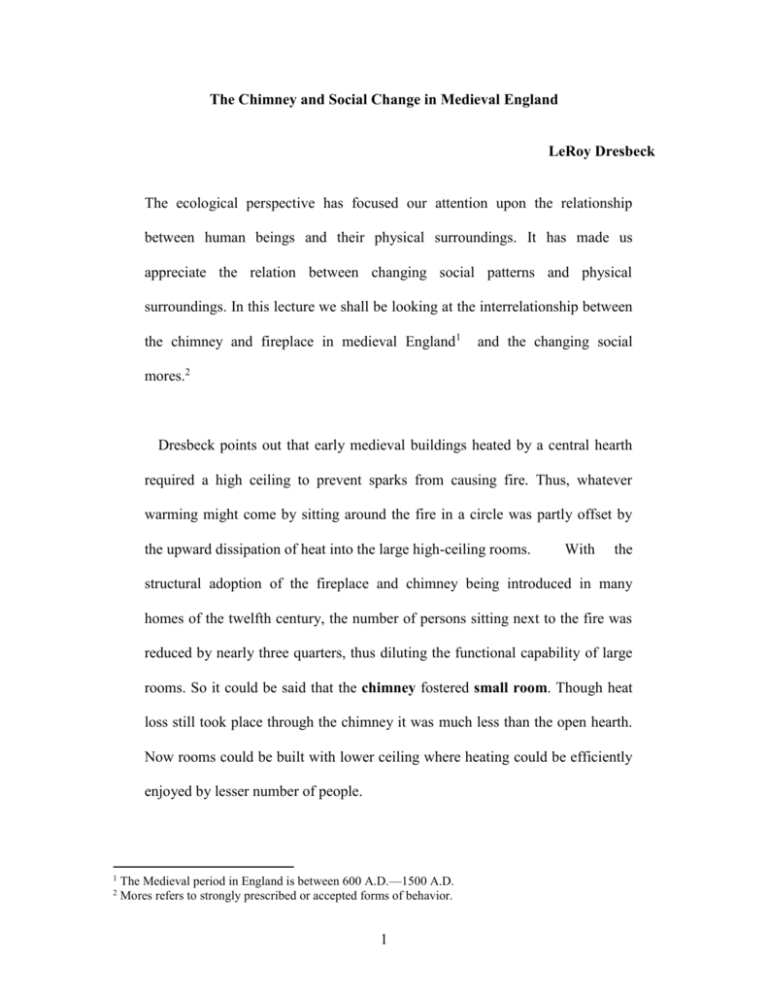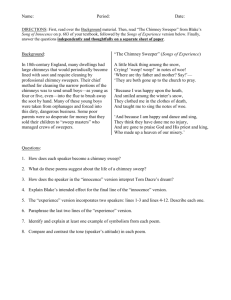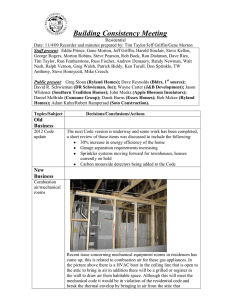The Chimney and Social Change in Medieval England
advertisement

The Chimney and Social Change in Medieval England LeRoy Dresbeck The ecological perspective has focused our attention upon the relationship between human beings and their physical surroundings. It has made us appreciate the relation between changing social patterns and physical surroundings. In this lecture we shall be looking at the interrelationship between the chimney and fireplace in medieval England1 and the changing social mores.2 Dresbeck points out that early medieval buildings heated by a central hearth required a high ceiling to prevent sparks from causing fire. Thus, whatever warming might come by sitting around the fire in a circle was partly offset by the upward dissipation of heat into the large high-ceiling rooms. With the structural adoption of the fireplace and chimney being introduced in many homes of the twelfth century, the number of persons sitting next to the fire was reduced by nearly three quarters, thus diluting the functional capability of large rooms. So it could be said that the chimney fostered small room. Though heat loss still took place through the chimney it was much less than the open hearth. Now rooms could be built with lower ceiling where heating could be efficiently enjoyed by lesser number of people. 1 2 The Medieval period in England is between 600 A.D.—1500 A.D. Mores refers to strongly prescribed or accepted forms of behavior. 1 This led to compartmentalization of rooms/space and productive work within domestic space. As the room size decreased there followed a tendency to divide the functions performed in them, establishing compartments based upon tasks. For example, the earlier art theme of a man sitting by a fire warming his bare feet got replaced by such themes as man stirring a pot hanging on the fireplace. Changing technological factors influenced a reinterpretation of an art motif which frequently emphasized activity and work. So partitioning which occurred for warmth substantially altered views toward labour. Since the new method of heating permitted compartmentalization, the medieval house ceased to be a residence only and became an agent for a wider scope of more productive work. In all occupations from government service to home-based industries fireplace and chimney helped to overcome the cold. The compartmentalization of rooms in turn had important social implications such as growth of the idea of privacy. Once the castles installed the chimney and the fireplace, dancing was easier as there was no central hearth. But at the same time the king could retire into a private room from the noise and publicity of the hall. Where the king spends his time was not a trivial issue. After the remodeling the king spent most of his time in his private rooms and the great hall was used for strictly ceremonial functions. It is pointed out that Henry III seized upon this as means of escaping the confusion of the hall or great chamber. 2 It is also pointed out that class divide widened due to structural changes in house design. Royal staff was divided into separate rooms from a central hall which also led to bureaucratic divisions. In later Middle Ages building chimneys were part of increasing royal expenditure. Often this was a reward for knights who performed service for the king. The nobles were quick to imitate the king in enjoying the new technology. Poems from this period lament this tendency in the following words: Woe is in the hall in all times and seasons Where neither lord nor lady likes to linger Now each rich man has a rule to eat in secret In a private parlour, for poor folk’s comfort In a chamber with a chimney, perhaps, and leave the chief assembly Which was made for men to have meat and meals in Dissemination of fireplace and chimney to the poorer sections: In poorer homes when chimney was found it was not partitioned. Paintings of farmhouse from the fifteenth century have the theme where a whole family sits around the fireplace. It shows that the poor were also beginning to introduce the new heating technology into their homes. Gradually the connection between warmth, comfort and privacy applied to people in all levels of the economic and social scale. Chimney as a status symbol (conspicuous consumption): Very soon the need for heat became a symbol of ‘conspicuous consumption’ among the upper 3 classes. A 1320 miniature painting shows a gentleman dressing in front of the fireplace. Also the concept of a separate bedroom emerged. Slowly even public buildings started having this new technique of heating. In 1214 there was an interesting case where a fireplace was constructed for an almonry where beggars waited to collect alms. In York, prisons were provided with fireplaces.3 Chimneys were installed in shops and taverns. Therefore, they were installed in public buildings as well as private spaces. Initially, it was the prerogative of the rich but also benefited the poor. Between twelfth and fourteenth century the entire spectrum of society witnessed the development of chimney and it is important to understand how the new heating technology affected the spectrum of society and changed the mores of medieval life. Reference: Dresbeck, LeRoy “The Chimney and Social Change in Medieval England” Albion: A Quarterly Journal Concerned with British Studies, Vol. 3, No. 1, (Spring, 1971), pp. 21-32. 3 Here discuss the story ‘The Cop and the Anthem’ by O. Henry 4











